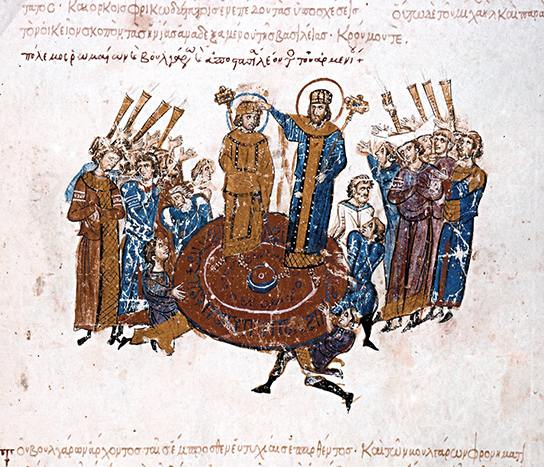- About Us
- Latest News
- Calendar
- Education
- School History
- ELA - For Toddlers
- Greek as a Second Lang.
- Greek as a Primary Lang.
- Conversational Skills (Online)
- Online Greek Courses
- Greek for Adults
- Ancient Greek
- Open Seminars
- Creative Drama
- Traditional Greek Dance
- Apply to Teach
- Holiday Program Enrolment
- Excursion - Museum
- School Polo Order Form
- Parent Notice to School
- Community Churches
- Membership
- Greek Centre
Eventlist
Event

- Title:
- Open Seminar: Picturing Byzantium: the richly ill/trated 12th-c Syn/sis of Histories by J. Skylitzes
- When:
- 25.06.2015 19.00 h
- Where:
- Greek Centre Melbourne (Mezzanine) - Melbourne
- Category:
- Education
Description
Lecturer: Senior Fellow John Burke
Entry: Free
Abstract
The Madrid Skylitzes manuscript, with its 575 richly-coloured miniatures, is of immense importance to art historians. It the only surviving illustrated Byzantine Greek chronicle, and it may well be Europe's first illustrated history book.
As befits a political-military history, the miniatures portray coronations, weddings, baptisms, deaths, consecrations of patriarchs, blindings, castrations, torture, murders, executions, assassinations, court trials, sieges, battles on land and sea (including Greek fire), conspiracies, rebellions, diplomatic exchanges, dinners, dreams, miracles, palaces, churches, processions, cities — even chariot racing, a school, and surgery on conjoined twins. These illustrations have been seen as visualizations of life in Byzantium. They feature on a large number of book covers and, for example, Greek and Cypriot stamps and school history books.
Eleven poems about various Byzantine emperors copied into the manuscript's margins are also of considerable interest.
The manuscript is a luxury product. At least seven artists are believed to have been involved in painting the miniatures. Parts of the manuscript have been lost, and it was never fully finished. The completed work might have had more than 700 miniatures. The parchment folios are large, 355 mm x 540 mm (about the size of four A4 sheets). The skins of some 135 sheep or goats were needed for the manuscript's production.
The text illustrated in the manuscript is John Skylitzes' Synopsis of Histories, which is one of the major surviving Byzantine chronicles. Skylitzes, in his prologue, presents himself as continuing the work of George Synkellos, who wrote around the year 810 AD and whose Chronographia covers the period from the creation of the world to the accession of the emperor Diocletian in 284 AD, and that of George's successor, Theophanes the Confessor, whose Chronicle took the story up to the end of the reign of Michael I Rangabes in 813. Skylitzes mentions a number of historians whose work he critically evaluated, digested, and turned into a concise, credible and readable narrative of the years 811-1057. Skylitzes is our only source for considerable parts of these years. Another text, conventionally known as Skylitzes Continuatus and possibly written by Skylitzes himself, continues the account from 1057 to 1079. Presumably, therefore, Skylitzes' Synopsis of Histories was published in the 1060s or early 1070s. The Madrid Skylitzes copy has been dated, on the basis of its handwriting, to the middle decades of the twelfth century, which makes it one of the earliest surviving manuscript copies of Skylitzes.
Although not all scholars agree, the Madrid Skylitzes was the first Skylitzes manuscript to be illustrated, and it was produced in Sicily. Significantly, Skylitzes covers the whole period of the Arab conquest of Sicily from 831 until the last Byzantine attempts at reconquest in 1042. The Normans under Roger I wrested Sicily from the Arabs in 1091. The administration of twelfth-century Norman Sicily and Southern Italy was conducted in Greek, Arabic and Latin. This multicultural mix is evident in the magnificent mosaics and other decoration adorning churches in Monreale, Palermo, Cefalú and elsewhere. Art historians have identified both a Byzantine and a western style in the miniatures of our manuscript, along with familiarity with the Arab world. Norman Sicily was a thriving centre of artistic and scholarly production. It was in Sicily that Ptolemy's astronomical treatise known as the Almagest was first translated into Latin from a copy presented to king Roger II (r. 1105-1154) by the Byzantine emperor, Manuel I Komnenos (r. 1143-1180), as well as some of Plato's dialogues and Ptolemy's Optics. Also commissioned were a Greek treatise on the five patriarchates, a comprehensive treatise on geography in Arabic, and translation into Latin of some works of Gregory Nazianzenus and Diogenes Laertius.
A note at the top of the manuscript's title page declares that it belonged to the monastery of San Salvatore (τοῦ Σωτῆρος) in Messina. Founded in 1121, this monastery was upgraded in 1134 by royal chrysobull to an archimandrate with oversight of some forty Greek-rite monasteries in Sicily and Calabria. An unillustrated twin of our manuscript, now in Naples, has a dedication indicating that it was sent from Messina. The humanist scholar Constantine Laskaris (1434-1501), who moved to Italy after the fall of Constantinople and eventually settled in Messina, where he taught Greek, wrote notes in our manuscript's margins and made a short summary of the text for his own use. Laskaris bequeathed his library to the senate of Messina, but it seems that the Skylitzes was never returned to the monastery. After a revolt in 1679, the Spanish governor confiscated the senate's archive and library and removed them to Palermo. The next governor had the books bound, and he took them to Spain when he left Sicily. He supported the losing party in the Spanish war of succession and in 1712 his library was confiscated and became part of the royal library, which then became the National Library of Spain, where the Madrid Skylitzes is now preserved.
Eight apographa of the Madrid Skylitzes are known, all of them made in the sixteenth century. Though none are illustrated, some have the captions to the miniatures, others the marginal poems, and one has both. One of these apographa was collated with a Vatican Skylitzes manuscript and translated into Latin in 1570. Since the 1973 editio princeps, Skylitzes translations have appeared in German, Armenian, Modern Greek, French and English.
The entire manuscript can be viewed at http://bdh-rd.bne.es/viewer.vm?id=0000022766
Bio
John Burke is a Senior Fellow in the School of Historical and Philosophical Studies at the University of Melbourne. After degrees in Classics and Patristics, he studied Medieval and Modern Greek history, language and literature at the University of Thessaloniki. He taught Latin, Ancient Greek and Classical Studies at Melbourne University, and Modern Greek at Melbourne, Monash and LaTrobe. For several years he served as chair of examiners for VCE Modern Greek, member of the 3ZZ Greek Program Committee, and secretary of the Modern Greek Studies Association of Australia and New Zealand. The University of Thessaloniki commissioned him to translate the official Greek grammar book, Manolis A Triantaphyllidis. Concise Greek Grammar (1997), and he contributed to Lonely Planet’s Greek Phrasebook (2000) and World Food Series: Greece (2002). He co-edited Neohellenism (1992), two volumes of Byzantine Macedonia (2000, 2001), and Byzantine Narrative (2006). He contributed to the Illustrated Catalogue of Greek Vases at The University of Melbourne (2000), volumes 4 and 5 of Proclus, Commentary on Plato's Timaeus (2010, 2013), and Jebel Khalid on the Euphrates, vol. 4: The housing insula (2014); for the latter he produced a DVD catalogue of 6330 objects with 5666 digital images, having earlier created the on-line Classics & Archaeology Virtual Museum (http://vm.arts.unimelb.edu.au/). Articles in scholarly publications include ‘The Madrid Skylitzes as an Audio-Visual Experiment’ (2006), ‘Three Copies of the Madrid Skylitzes’ (2007), ‘Inventing and re-inventing Byzantium: Nikephoros Phokas, Byzantine Studies in Greece and “New Rome” ’ (2014), ‘Mainstream texts, viral media and hidden agendas in the tradition of patria texts', (2014). With colleagues he is preparing an English translation of the late twelfth-century World Chronicle of George Kedrenos.
Sponsors
Our sincere thanks to: Nick Koukouvitakis, Leonidas Argyropoulos, Louis & Effie Sgardelis for sponsoring this seminar.
During the course of the year considerable expenses are incurred in staging the seminars. In order to mitigate these costs individuals or organisations are invited to sponsor a lecture of their choice. Please email: This e-mail address is being protected from spambots. You need JavaScript enabled to view it
You too can sponsor one or more seminars and (optionally) let your name or brand be known as a patron of culture to our members, visitors and followers, as well as the broader artistic and cultural community of Melbourne.
We also thank the seminars' corporate sponsors:

Venue
- Venue:
- Greek Centre Melbourne (Mezzanine) - Website
- Street:
- 168 Lonsdale Street
- Postcode:
- 3000
- Suburb:
- Melbourne
- State:
- VIC
- Country:
-

The Mezzanine floor (press "M" in the elevator) of Greek Centre Melbourne - located at the corner of Lonsdale and Russell streets in Melbourne, Australia.
EventList powered by schlu.net







